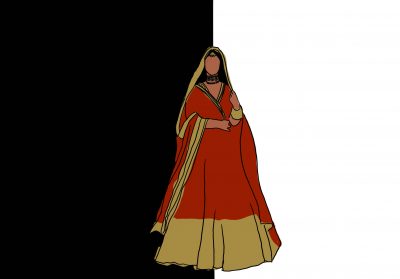If you’ve been on TikTok recently, you’ll no doubt have realized that internet troll Trisha Paytas has a new persona: the Hindu yogi. Considering the multitude of identities she’s cycled through, Trisha’s next new “lifestyle” shouldn’t have taken me by surprise, but let’s just say three minutes of Trisha chanting “Hare Kreeshna Hare Ramma” on TikTok wasn’t exactly the Diwali surprise I was looking for. On the bright side, this ‘Trisha X Hinduism’ collaboration’s convergence with the Hindu festival of lights creates the perfect backdrop to discuss an important development in Indian fashion: Sabyasachi’s Mangalsutra campaign.
I know “Sabyasachi” and “Mangalsutra” might sound like ambiguous Harry Potter spells, so let me provide some context. Sabyasachi Mukherjee is one of the biggest fashion and jewelry designers in India today, known for his revolutionarily subversive design and somewhat less subversive, maybe-I-don’t-need-a-new-Indian-outfit prices. For those who aren’t deterred by the costs — basically every nepotism-borne Bollywood actress ever — Sabyasachi outfits seem to have become a second skin.

The second term, Mangalsutra, refers to a necklace originating in the 6th century A.D. worn by married Hindu women to signify their marital status. Symbolizing the unbreakable union between husband and wife, the auspicious thread forms a vital part of the important Hindu tradition of tying the Mangalsutra during the marriage ceremony.
Enter Sabyasachi, in all his overpriced cotton sari, selectively diverse novelty. His plan to market the traditional chain as part of a hyper-modern, Calvin Klein-style inclusive campaign seems straight out of an ambitious Ad Club pitch, sure to empty the wallets of socially progressive and culturally traditional elites. Except it didn’t.
Sabyasachi’s attempt to address the heteronormative and puritanical aspects of Hindu marriage through a risqué campaign featuring models in undergarments occasionally hugging or leaning on each other angered many Hindus. From angry tweets to suggestions of the correct way to advertise a Mangalsutra — placed modestly over a sari, of course — it was evident that many Indians considered the campaign a Trisha Paytas-like adulteration of Hindu culture.
The crusade to save Mangalsutra morality culminated in an official statement from the Bharatiya Janata Party, India’s ruling Hindu nationalists, enacting a 24-hour ultimatum to Sabyasachi to withdraw the advertisement or face statutory action. Sabyasachi obliged, but not before expressing sadness that his message of “inclusivity and empowerment” had caused offense.
As an American, the thought of a hypothetical analogous situation, like, I don’t know, Mitch McConnell threatening criminal punishment on the 2018 Met Gala for its weird fetishization of Catholicism, feels so bizarre that I can’t help but meet the Sabyasachi backlash with some degree of incredulity. As an Indian, however, I can understand the outcry.
The Mangalsutra holds such meaningful long-standing tradition that associating it with nudity and intimacy cheapens the beautiful symbol and its complexity. Is vulgarity really the only attractive selling point of the auspicious thread? Despite these concerns, however, I believe Sabyasachi’s ultimate motive — to make the idea of marriage more inclusive through the inclusion of same-sex couples and darker-skinned models — is commendable.
In my opinion, Sabyasachi’s main mistake was applying a Western model of inclusivity to an Eastern audience.
In the United States, a Tiffany & Co. necklace does not have centuries of tradition behind it forming lasting loyalty to its religious values — though its price may inspire similar feelings of awe. As a result, creating inclusivity in the culture of Tiffany wearers requires, say, the firing of directors who have let loose a few too many microaggressions to be attributed to being a boomer, and some strategic diversity in advertising campaigns.
In other words, these optics could provide American eyes relief from the constant barrage of Kate Moss replicas in fashion. And though this process may feel superficial because there is no complex tradition behind the jewelry, rebranding its image doesn’t chafe against any established values.
For Sabyasachi, this add-some-diversity-and-nudity campaign failed to make Hindu marriage and the Mangalsutra more inclusive because it didn’t actually address the rich culture behind it. Additionally, the norm of seeing nudity as an artistic choice rather than a form of disrespect exists only within a limited, privileged and Western sphere. Though unfortunate that bodies continue to be so widely stigmatized, Sabyasachi should have realized that an Indian audience would not respond in the same way to nudity, especially in association with a religious symbol.
If you ask me, it’s high time Hindu culture became more inclusive and accepting, especially surrounding marriage and relationships. However, Mahatma Gandhi didn’t go on 18 different fasts for us to continue looking to the West for change.
India has always been a place of dynamism and diversity. Tapping into its own culture and traditions at a human level, therefore, could be a much better starting point for shifting people’s mindsets than attempting to fit the mold of corporate Western “inclusivity.”























































































































